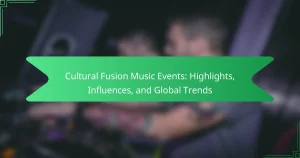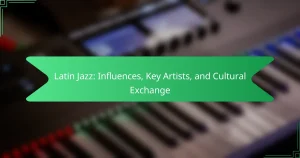Afrobeat is a dynamic genre that blends traditional African rhythms with jazz, funk, and modern influences. This article explores its origins in Nigeria, the evolution through global collaborations, and the socio-political commentary embedded in its lyrics. Contemporary artists like Burna Boy and Wizkid showcase Afrobeat’s adaptability and appeal, while cultural festivals promote its vibrant sound worldwide. Challenges faced by Afrobeat artists in the global music industry are also examined, highlighting the complexities of maintaining cultural identity.
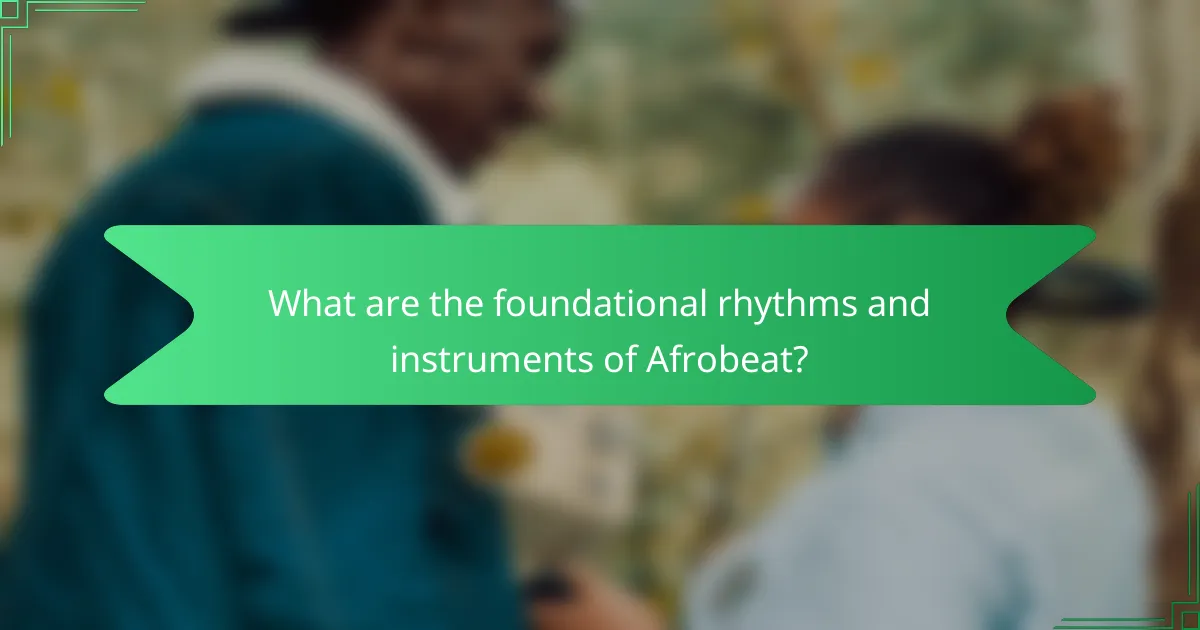
What are the foundational rhythms and instruments of Afrobeat?
Afrobeat is characterized by intricate rhythms and a variety of instruments. The foundational rhythms include polyrhythmic patterns that create a vibrant groove. Key instruments are drums, bass guitar, electric guitar, and horns, which contribute to its unique sound. These elements combine to form the genre’s energetic and danceable quality.
How do traditional African music elements influence Afrobeat?
Traditional African music elements significantly shape Afrobeat’s rhythms, instrumentation, and vocal styles. The use of polyrhythms, call-and-response patterns, and diverse instruments like the talking drum enhances its unique sound. Afrobeat’s roots in highlife and traditional African genres reflect a blend of cultural influences. This fusion creates a vibrant musical genre that resonates globally, showcasing the richness of African heritage.
Which instruments are essential to Afrobeat’s sound?
Essential instruments for Afrobeat’s sound include the drum kit, electric bass, guitar, brass instruments, and keyboards. These elements create a fusion of African rhythms and jazz influences.
The drum kit provides the foundational groove, while the electric bass adds depth and resonance. Guitars often play syncopated riffs, enhancing the rhythmic complexity. Brass instruments, such as trumpets and saxophones, contribute powerful melodies and harmonies. Keyboards add texture and layers, enriching the overall sound.
Together, these instruments form the core of Afrobeat, allowing for dynamic performances and innovative collaborations.
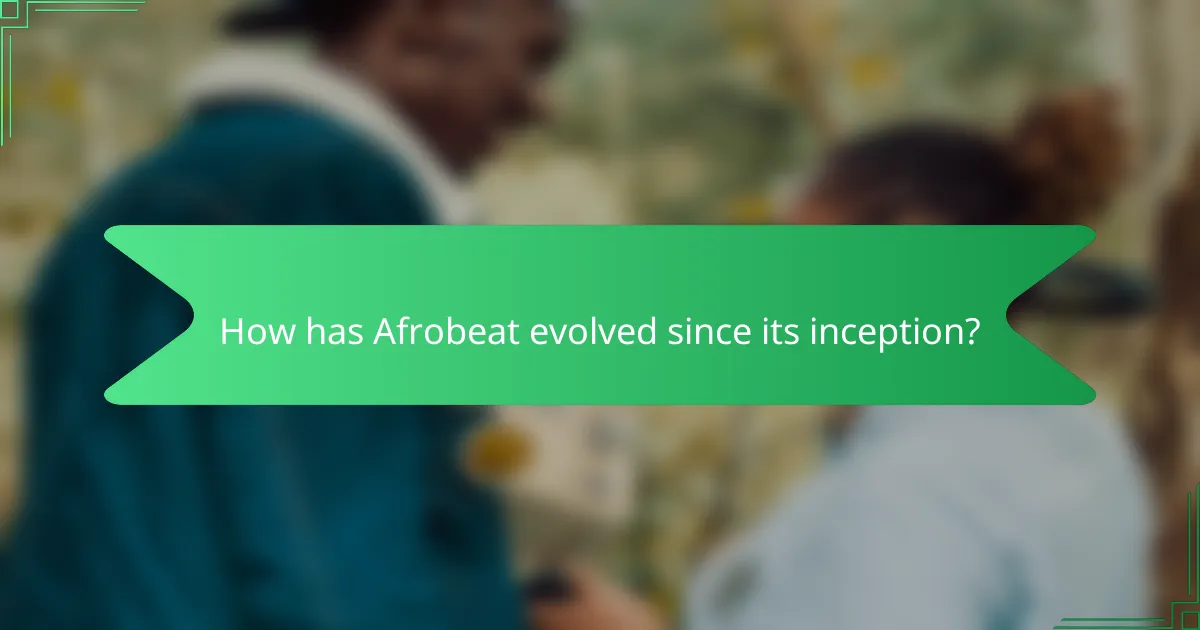
How has Afrobeat evolved since its inception?
Afrobeat has evolved significantly since its inception in the 1960s, blending traditional African music with jazz, funk, and highlife. Initially popularized by Fela Kuti, Afrobeat has expanded globally, influencing various genres and artists.
The genre’s evolution includes the incorporation of electronic elements and collaborations with international musicians. Contemporary artists like Burna Boy and Wizkid have introduced Afrobeat to wider audiences, showcasing its adaptability and relevance.
Afrobeat’s unique attribute lies in its fusion of complex rhythms and social commentary, which continues to resonate in today’s music scene. As a result, Afrobeat not only preserves its roots but also embraces modern influences, ensuring its ongoing evolution.
What key historical events shaped the development of Afrobeat?
Key historical events that shaped Afrobeat include Nigeria’s post-colonial independence in 1960, which inspired a fusion of traditional African rhythms with jazz and funk. The influence of Fela Kuti, the genre’s pioneer, during the 1970s introduced political themes and social commentary, reflecting the struggles against authoritarian regimes. The global recognition of Afrobeat grew in the late 20th century, particularly during the 1990s, as international collaborations emerged, further evolving the sound and expanding its audience. These milestones collectively contributed to Afrobeat’s rich tapestry and ongoing legacy in global music.
Who are the pivotal figures in the evolution of Afrobeat?
Fela Kuti, Tony Allen, and Antibalas are pivotal figures in the evolution of Afrobeat. Fela Kuti, the genre’s founder, blended traditional African music with jazz and funk. Tony Allen, Kuti’s drummer, innovated Afrobeat rhythms, influencing global music. Antibalas, a contemporary ensemble, revitalized Afrobeat, expanding its reach and collaborations. These artists shaped Afrobeat’s sound, culture, and global impact.
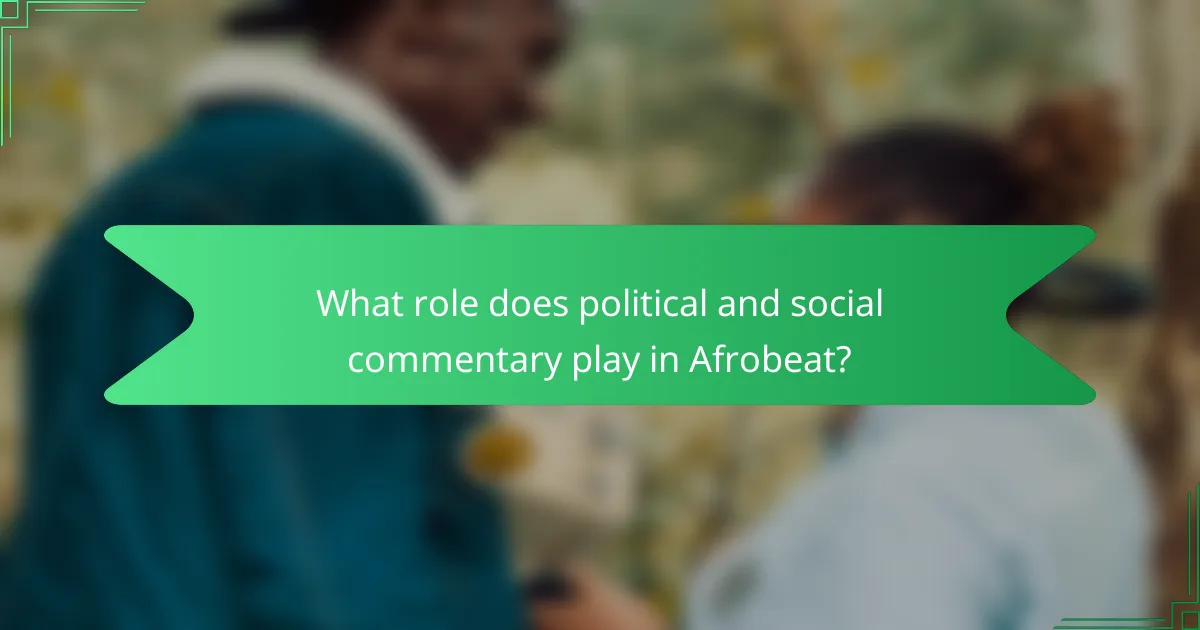
What role does political and social commentary play in Afrobeat?
Political and social commentary is integral to Afrobeat, serving as a vehicle for activism and cultural expression. Afrobeat artists often address issues such as inequality, corruption, and social justice, reflecting the socio-political landscape of their communities. This genre originated in Nigeria during the 1960s, with Fela Kuti as a pioneering figure, using music to challenge oppressive regimes. The unique attribute of Afrobeat is its blend of traditional African rhythms with jazz and funk, enhancing its global appeal and message. As a result, Afrobeat has influenced movements worldwide, promoting awareness and change through its powerful lyrics and engaging performances.
How do Afrobeat artists address social issues through their music?
Afrobeat artists address social issues through their music by using powerful lyrics and rhythms to highlight inequality, corruption, and social justice. They often draw from personal experiences and cultural narratives, creating a platform for activism. For example, artists like Fela Kuti and Burna Boy tackle topics such as police brutality and political oppression, resonating with audiences worldwide. Their music serves as a catalyst for conversation and change, fostering awareness and encouraging collective action. This unique attribute of Afrobeat as a tool for social commentary enhances its global appeal and relevance.
Which notable songs exemplify political themes in Afrobeat?
Notable songs that exemplify political themes in Afrobeat include “Zombie” by Fela Kuti, which critiques military regimes, and “International Thief Thief” by Fela Kuti, addressing corruption. “Baba Fela” by Seun Kuti honors his father’s legacy while promoting social justice. “Black President” by Fela Kuti expresses resistance against oppression. “Juju Music” by King Sunny Adé incorporates political commentary through cultural expression. These tracks highlight Afrobeat’s role in social and political discourse.
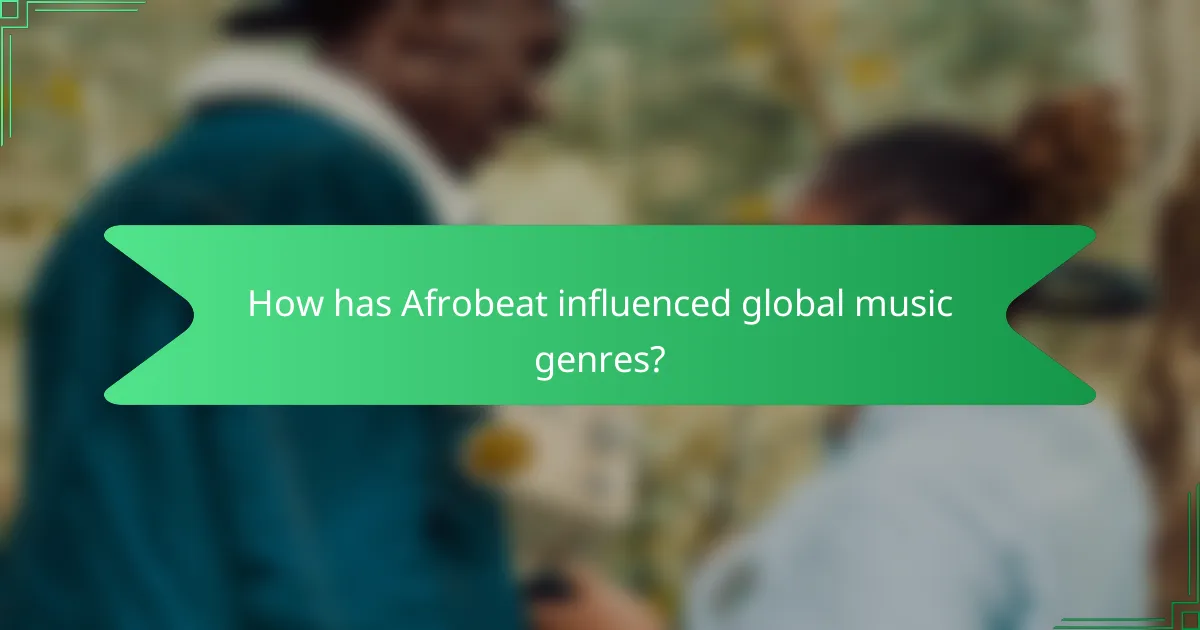
How has Afrobeat influenced global music genres?
Afrobeat has significantly influenced global music genres by blending traditional African rhythms with jazz, funk, and soul. This genre originated in Nigeria during the late 1960s, primarily through Fela Kuti’s innovative sound. Afrobeat’s complex polyrhythms and socially conscious lyrics have inspired artists worldwide, leading to collaborations across genres. For example, contemporary musicians like Beyoncé and Drake incorporate Afrobeat elements, illustrating its global reach. The genre’s unique attribute lies in its ability to fuse diverse musical styles while maintaining a strong cultural identity, making it a driving force in the evolution of modern music.
What are the cross-genre collaborations that showcase Afrobeat’s impact?
Afrobeat has significantly influenced various music genres through cross-genre collaborations. Notable examples include Burna Boy’s collaboration with Ed Sheeran on “Own It,” blending Afrobeat with pop. Wizkid’s partnership with Drake on “One Dance” showcases Afrobeat’s reach into hip-hop. Additionally, Major Lazer’s work with Nigerian artists like Tiwa Savage highlights Afrobeat’s fusion with electronic dance music. These collaborations illustrate Afrobeat’s global appeal and its ability to merge with diverse musical styles.
Which artists outside Africa have integrated Afrobeat into their work?
Several artists outside Africa have successfully integrated Afrobeat into their work. Notable examples include British musician Sampha, known for blending Afrobeat rhythms with electronic music, and American singer Beyoncé, who incorporated Afrobeat influences in her album “The Lion King: The Gift.” Other prominent artists include Canadian rapper Drake, who has collaborated with Afrobeat artists, and British singer Jorja Smith, who draws inspiration from the genre. These collaborations highlight Afrobeat’s global appeal and its influence on diverse musical styles.

What are the unique characteristics of contemporary Afrobeat artists?
Contemporary Afrobeat artists are characterized by their fusion of traditional African rhythms with modern genres. They often incorporate elements of jazz, funk, and hip-hop, creating a unique sound that appeals globally. Artists like Burna Boy and Wizkid exemplify this blend, showcasing rich instrumentation and dynamic vocal styles. Their lyrics frequently address social issues and cultural identity, reflecting a deep connection to their roots while engaging with contemporary themes. This duality enhances their appeal and establishes Afrobeat as a significant force in the global music scene.
How do modern Afrobeat artists innovate while respecting tradition?
Modern Afrobeat artists innovate by blending traditional rhythms with contemporary genres, enhancing global appeal. They respect tradition through collaborations with seasoned musicians, incorporating authentic sounds while experimenting with new technologies. This fusion maintains Afrobeat’s cultural roots while attracting diverse audiences. Unique elements, such as the use of digital production techniques, allow artists to reach broader platforms, showcasing Afrobeat’s evolution. As a result, they honor their heritage while pushing creative boundaries, ensuring the genre’s relevance in today’s music landscape.
Which emerging Afrobeat artists are gaining international recognition?
Several emerging Afrobeat artists are gaining international recognition, including Ayra Starr, Omah Lay, and Tems. Their unique sounds and collaborations with global artists have propelled them into the spotlight. Ayra Starr’s debut EP showcased her vocal talent, while Omah Lay’s fusion of Afrobeat and R&B has attracted a diverse audience. Tems gained acclaim through her feature on Wizkid’s “Essence,” further highlighting her distinct style. These artists exemplify the evolution of Afrobeat and its global appeal.

How do cultural festivals and events promote Afrobeat worldwide?
Cultural festivals and events significantly promote Afrobeat worldwide by showcasing its vibrant rhythms and diverse influences. These gatherings create platforms for artists to perform, collaborate, and engage with global audiences. Festivals like AfroPunk and the Lagos Jazz Series attract international attendees, amplifying Afrobeat’s reach and cultural exchange. Collaborative projects with artists from different genres further enhance its global appeal, blending Afrobeat with various musical styles. This fusion not only enriches the genre but also introduces it to new listeners, fostering a broader appreciation and understanding of Afrobeat.
What are the major Afrobeat festivals and their significance?
Major Afrobeat festivals include the Afro Nation festival, the Lagos Jazz Series, and the Felabration festival. These events celebrate Afrobeat music and culture, promoting artists and fostering community connections. Afro Nation, for instance, attracts global audiences and showcases diverse talent, enhancing Afrobeat’s international presence. Felabration honors the legacy of Fela Kuti, emphasizing Afrobeat’s historical significance and cultural roots. These festivals play a crucial role in the evolution of Afrobeat, supporting its growth and global collaborations.
How do these events foster community and cultural exchange?
Afrobeat events foster community and cultural exchange through shared experiences and collaborative performances. These gatherings unite diverse audiences, promoting understanding and appreciation of African rhythms and traditions. Artists collaborate across genres, creating fusion that highlights cultural diversity. The global reach of Afrobeat invites international participation, enhancing cultural dialogue and connections. Through music, attendees engage in cultural storytelling, enriching their perspectives and fostering inclusivity.
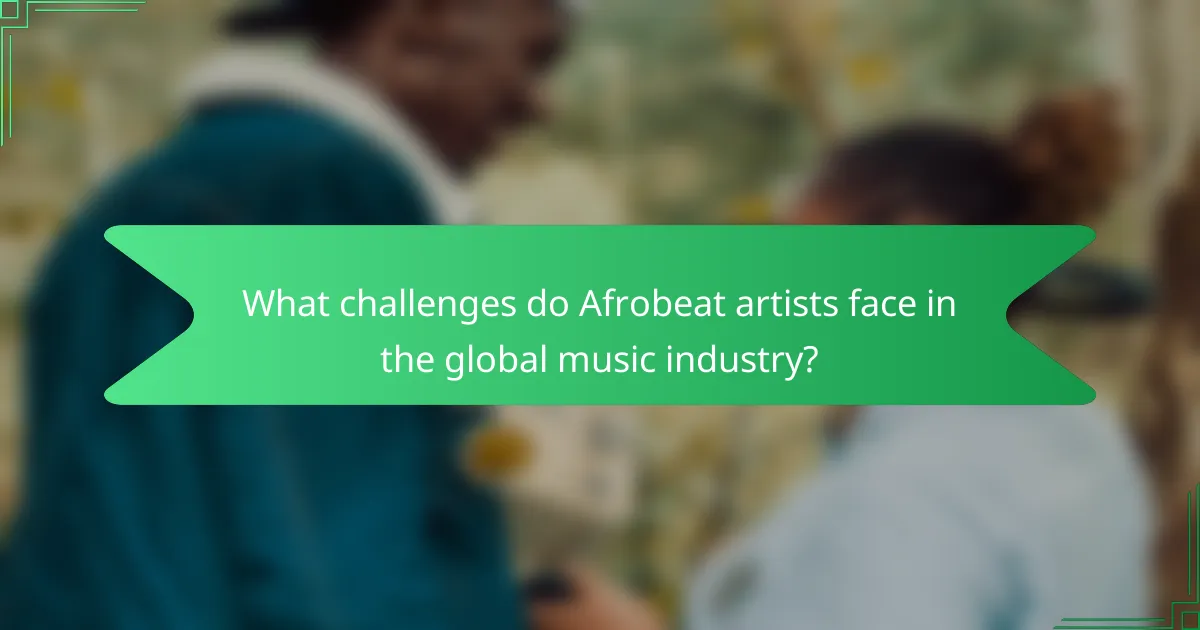
What challenges do Afrobeat artists face in the global music industry?
Afrobeat artists face numerous challenges in the global music industry, including market saturation and cultural misrepresentation. Limited access to resources restricts their ability to produce high-quality music. Furthermore, navigating international copyright laws can hinder their revenue potential. Collaborating with established artists may offer visibility, but it can also dilute their unique sound. Lastly, the lack of mainstream media coverage often limits their reach and audience engagement.
How does the commercialization of Afrobeat affect artistic integrity?
The commercialization of Afrobeat can compromise artistic integrity by prioritizing marketability over authenticity. As artists seek commercial success, they may dilute their cultural messages to appeal to broader audiences. This shift can lead to a loss of traditional elements that define Afrobeat’s unique sound. Additionally, collaborations with mainstream artists often emphasize profit over cultural significance, potentially overshadowing the genre’s roots. The balance between commercial success and preserving artistic authenticity remains a critical challenge for Afrobeat musicians today.
What barriers exist for Afrobeat artists in gaining mainstream recognition?
Afrobeat artists face several barriers to mainstream recognition, including limited access to global music markets, cultural biases, and insufficient media coverage. These challenges hinder their ability to reach wider audiences. The genre’s roots in African culture may not resonate with all international listeners, making it harder for artists to gain traction. Additionally, competition from more established genres complicates the landscape further.
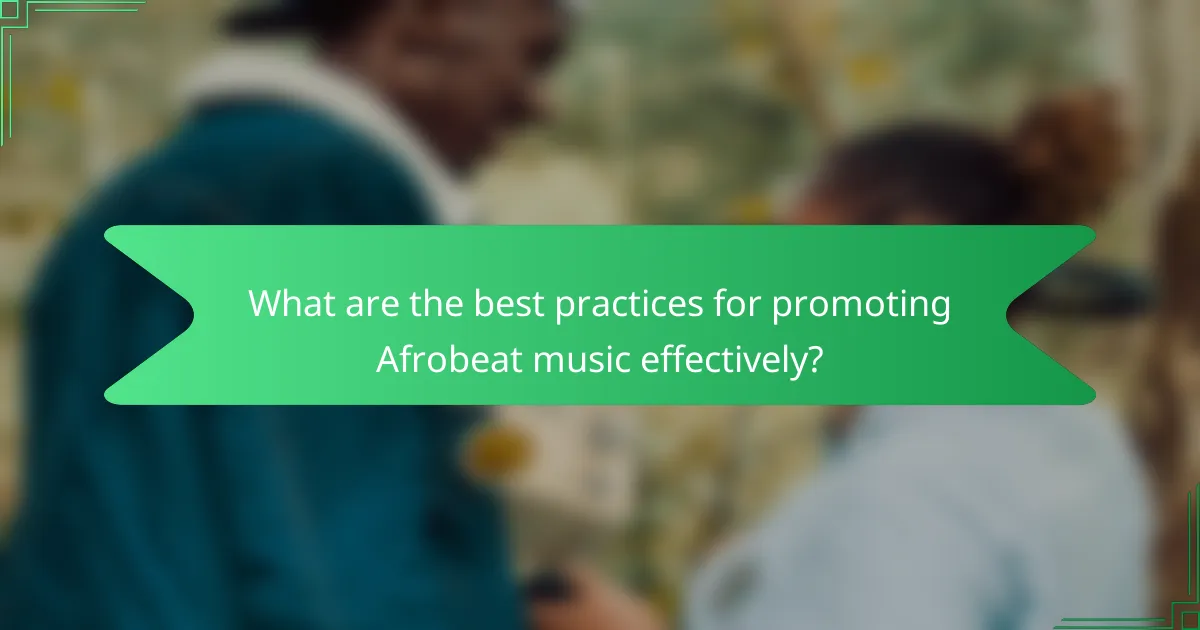
What are the best practices for promoting Afrobeat music effectively?
To promote Afrobeat music effectively, focus on strategic collaborations, social media engagement, and live performances. Collaborating with artists from diverse genres enhances visibility. Utilize platforms like Instagram and TikTok to reach younger audiences. Live shows create authentic connections and showcase the genre’s energy. Leverage Afrobeat’s unique cultural roots to attract global interest.
How can artists leverage social media to reach wider audiences?
Artists can leverage social media to reach wider audiences by curating engaging content, collaborating with influencers, and utilizing targeted advertising. These strategies enhance visibility and foster community engagement.
Engaging content includes behind-the-scenes looks, live performances, and storytelling that resonates with followers. Collaborating with influencers amplifies reach, as influencers can introduce artists to their established audiences. Targeted advertising allows artists to promote their work to specific demographics, increasing the likelihood of attracting new fans.
Social media platforms also provide analytics tools that help artists understand audience preferences, enabling them to refine their strategies. By consistently interacting with followers, artists can build loyalty and encourage word-of-mouth promotion, expanding their reach organically.
What strategies can be implemented to enhance collaboration within the Afrobeat community?
To enhance collaboration within the Afrobeat community, fostering open communication and shared projects is essential. Establishing platforms for artists to connect can drive innovation and creativity.
1. Organize collaborative workshops to share skills and techniques.
2. Utilize social media for networking and promoting joint ventures.
3. Create collective events that showcase diverse talents.
4. Develop mentorship programs linking established artists with emerging ones.
5. Encourage cross-genre collaborations to broaden Afrobeat’s appeal.
